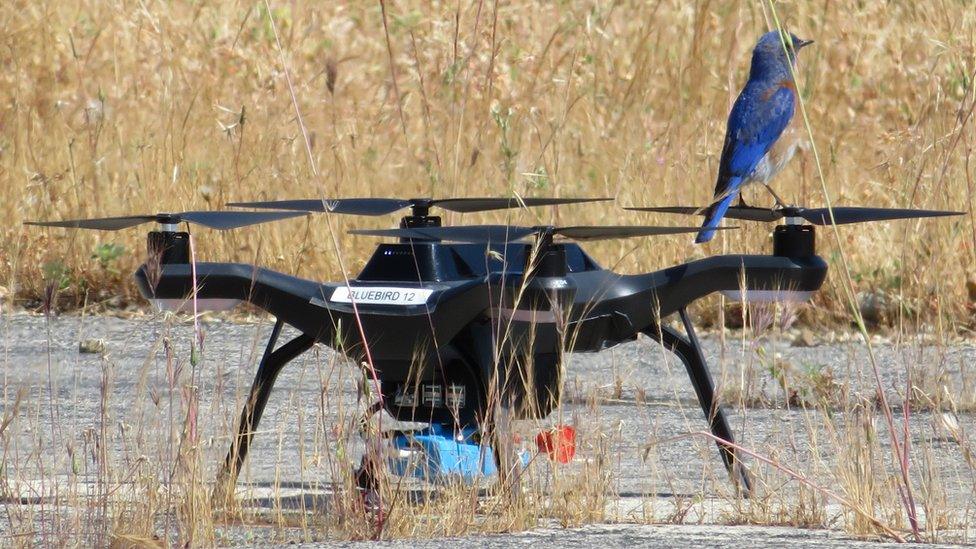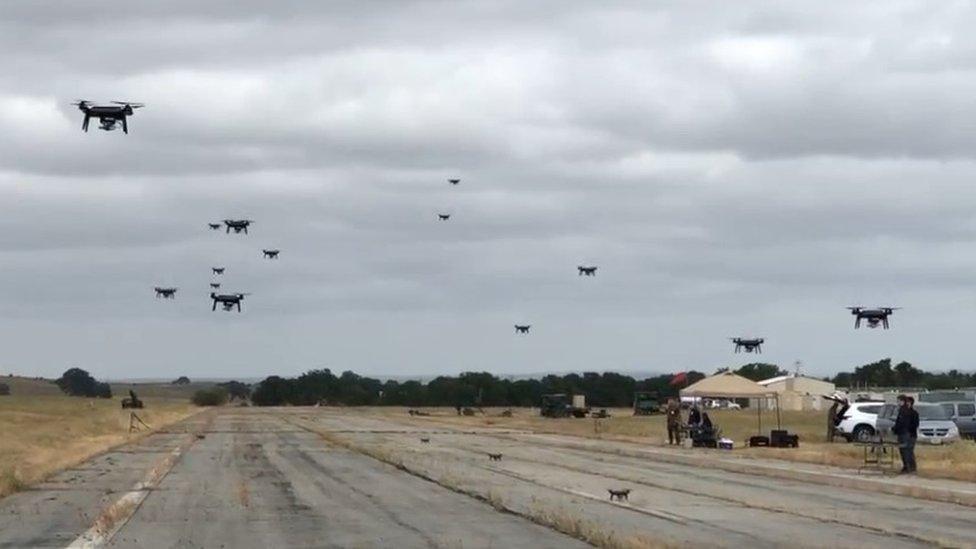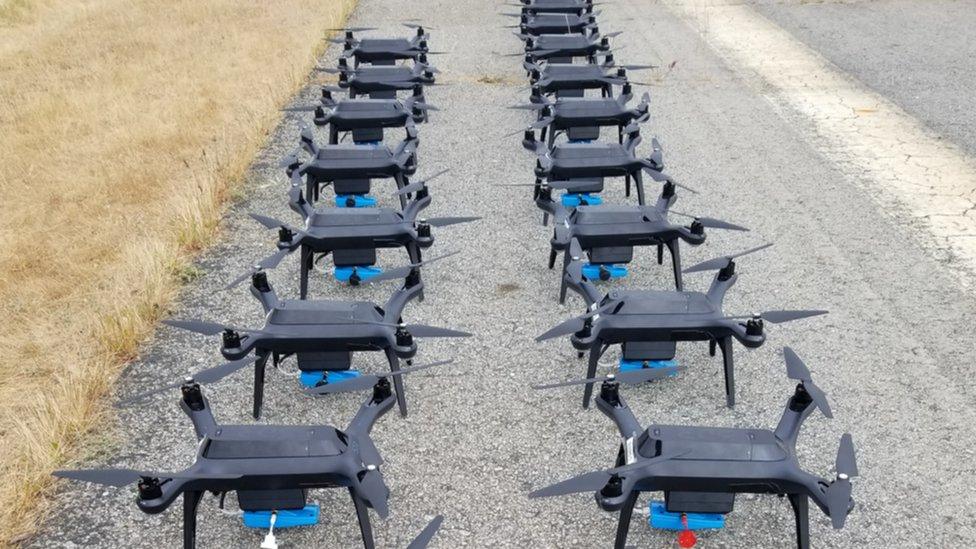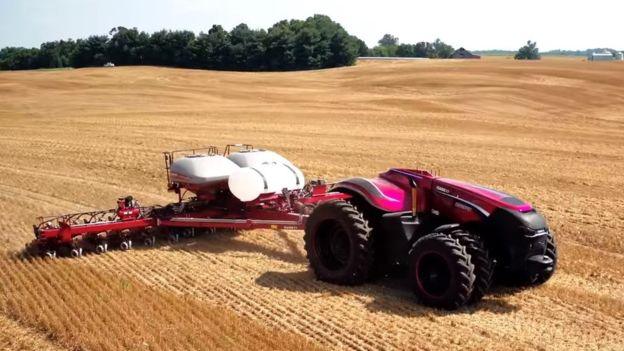If one drone isn't enough, try a drone swarm
- Published

Could co-operating drones mimic the behaviour of bird flocks?
When Bill Herz wants to know how his crops are doing, he launches a drone.
He has nearly a thousand acres of corn and soybeans in LaSalle, eastern Illinois. "My drone has saved me time and energy," he says.
"I don't need to walk a whole field to find a problem area. I can fly the field, look at the results and go right to it."
Drones used for farming belong to the arsenal of tools used for precision agriculture - hi-tech farming using data to make better decisions.
So far, flying robots have enabled farmers to live stream crop growth, patrol for pathogens and boost farm efficiency. The next step is to recruit squadrons of them that can co-operate and carry out their tasks without the need for a human pilot.
Scientists from the Norwegian Defence Research Establishment (FFI) and the US's Rajant Corporation are working on simultaneously flying about 20 drones that can work in co-ordination with little human supervision.

The synchronised swarm of drones comes to land on the airstrip
A simple command is all that is needed for the robots to self-organise and communicate in a decentralised way, much in the way flocks of birds or schools of fish move around and interact with each other when they want to "solve" a task requiring collective intelligence.
A Rajant-patented radio technology called "kinetic mesh" and "foreign function interface" distributed computing software are the technological ingredients behind this breakthrough.
"A typical drone of any size flies maybe 30 minutes or less," says Don Gilbreath, systems vice president at Rajant.
"If a farmer needs to map hundreds of acres of their field, it might take 50 battery charges. A swarm is essentially doing in parallel the same job up to 20 times faster than a single drone."
This "parallelisation of the workload" will single out healthy plants from sick ones and help farmers decide where to deliver more pesticides and nutrients, says Sondre Engebraten, a researcher at FFI.

Next year the research team will attempt to fly 100 co-operating drones
"These fleets will result in us having more and better crops. We've got to feed the planet," Mr Gilbreath maintains.
With the world's population projected to reach 10 billion by 2050, consumption of agricultural produce is expected to increase 70%.
But while swarms of drones may seem to be one answer to this productivity challenge, Sridhar Tayur, professor of operations management at Carnegie Mellon University's Tepper School of Business, sounds a sceptical note.
"How do swarms work in bad weather?" he asks. "What is the amount of management and maintenance of the technology needed?"


Cost is another issue. Mr Gilbreath estimates that a drone swarm will cost tens of thousands of dollars once it hits the market, making it unlikely that smaller farmers in developing economies will be able to afford one.
"Why would a farmer in Vietnam or India, where there is cheap labour, where hundreds of people could go to every row and figure out which plants are sick and healthy, buy a swarm?" asks Prof Tayur.
"Large firms in industrialised countries will experience a cost advantage through increasing their output, with the smaller farmer left behind unless they form a co-operative of some sort with other micro-farmers or sell highly specialised commodities.
"These are economies of scale in action," he says.
Dodging drone can avoid mid-air crashes
Farmer Bill Herz admits that, as a small grower, he wouldn't pay tens of thousands for a swarm of drones. But as a consultant for a company providing hi-tech agronomy services, he would certainly consider advising larger growers to shell out the money.
And he thinks there will be a business opportunity for service providers to manage the flying and maintenance of the drones on behalf of large - and perhaps smaller - farms.
"Farmers won't need to buy the swarm," says Mr Gilbreath. "They may say, I need my field analysed by tomorrow. A service provider may come in with 10 or 20 of these things and do it by lunchtime."
In most countries, commercial drone pilots have to be certified by aviation authorities, so certified service providers would also overcome the regulatory hurdles famers would face.

Autonomous tractors could work in tandem with drone swarms
Some, like Mr Engebraten and Mr Gilbreath, think farmers may be given special dispensations to use swarm drones, given that a drone crash in open farmland is far less risky than in a densely-populated urban area.
"There might be some proper training requirements and regulations for tracking and monitoring and noise, but I expect authorities will be reasonable," says Prof Tayur.
Next year, Mr Gilbreath and Mr Engebraten will be flying a fleet of up to 100 streamlined drones. They are currently tweaking their software and radio technology, making a drone platform tailored specifically to swarming and expanding the number of tasks the drone swarms can handle with a view to speeding up the process.
"If we tackle all these logistics and combine swarms with, say, autonomous tractors, it's not too far fetched to think that in the future we might have fully automated farming," says Mr Engebraten.
"Drones will be our eyes in the sky."
Follow Technology of Business editor Matthew Wall on Twitter, external and Facebook, external